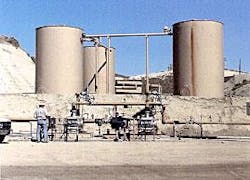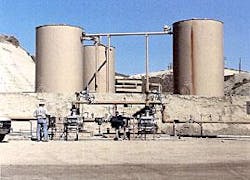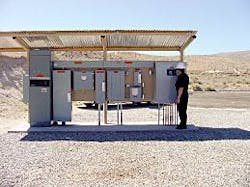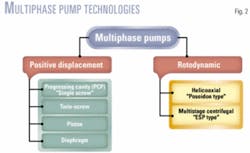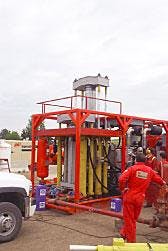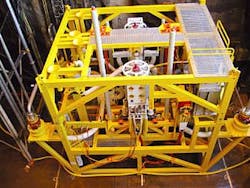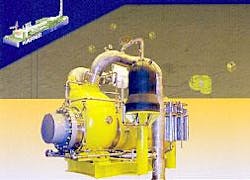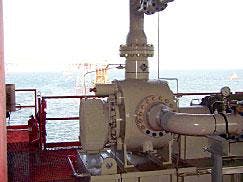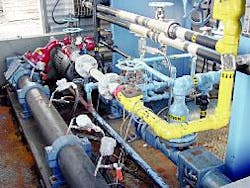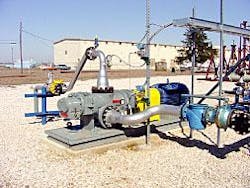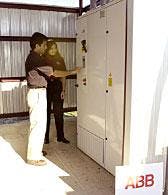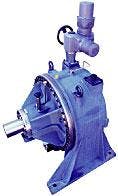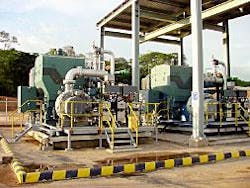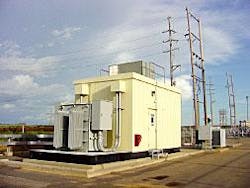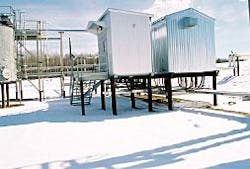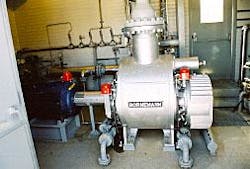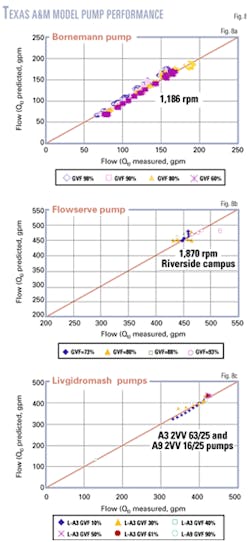Multiphase pumping addresses a wide range of operating problems
Multiphase pumping has evolved into a well-accepted "best practice" in many producing areas and is now being asked to solve a wide range of operational problems.
With hundreds of multiphase pumps now in operation, producers use multiphase pumps to reduce capital costs, improve production rates, and eliminate emissions.
Two very important new multiphase pump installations are:
1.Canadian Natural Resources Ltd.'s (CNRL) installation of 34 twin-screw multiphase pumps in the Alberta oil sands, Primrose field, with another 40 approved for installation during the next 4-5 years.
2.Amerada Hess Corp.'s installation of two subsea helicoaxial multiphase pumps in the Ceiba field, off Africa, with an additional four pumps scheduled for installation by yearend.
The following sections discuss the solutions provided by multiphase pumping as well as describing the variety of approaches employed to pump a multiphase mixture of oil, water, gas, and sometimes sand.
Also included are important new developments in this fast evolving area.
Multiphase flow
For years, the oil industry has pumped multiphase mixtures, more often by accident than by design. For example, pump-off controllers reduce "fluid pound" in sucker-rod pumps, while downhole gas separators prevent much of the produced gas from entering an electric submersible pump (ESP).
The reason for separating gas and liquid phases is that the industry has well developed technologies for pumping liquids and compressing gas. Only recently has the industry looked at the potential advantage of pumping a multiphase mixture.
Field development design would change if oil, water, and gas separation became unnecessary near the wellhead and these complex mixtures could be pumped to a single central facility for fluid processing.
Despite the common belief that wells with low GORs are oil wells, the primary fluid is almost always natural gas on a volumetric basis. This is true for even extremely low GOR wells. For wells producing water, calculations should consider the gas-liquid ratio (GLR). Typically only wells with high water cuts or that operate with high backpressure, such as subsea wells, will produce more liquid than gas volume.
Applications
A wide variety of needs has driven the demand for multiphase pump technology. Traditionally, it was a means for reducing backpressure on producing wells. For the properly selected well, this can increase production and improve ultimate recoveries.1 2
Pressure boosting that lowers wellhead pressure does not only accelerate reserve recovery, but also adds new reserves.
Other advantages include promoting environmental sustainability, reducing capital equipment costs, controlling pipeline slugging, and aiding flow assurance.
The greenhouse gas emissions reduction targets of the Kyoto Protocol and multiphase pumps provide an unexpected synergy. Finding better ways to produce oil and gas is a global issue. Venting tanks to the atmosphere and flaring gas are becoming quickly a thing of the past as various governments work on completely eliminating these emissions.
Installing vapor recovery systems on stock tanks is costly and complicated. Multiphase pumping, on the other hand, effectively eliminates wellsite tanks and the permitting and inspection complications.
Eliminating wellsite tanks, separators, and other equipment also reduces the footprint of oil and gas operations. This allows development of the same reserves with only a fraction of the surface facilities required a decade ago.
In many current applications, the driving force for multiphase pumping has simply been a reduction in equipment costs, although conventional separators, stock tanks, single-phase liquid pumps, and gas compression can also reduce wellhead pressure to near zero backpressure.
Fig. 1a shows multiphase pumping technology in the shadow of conventional technology outside of Bakersfield, Calif. Looming behind the two twin-screw multiphase pumps are the stock tanks and fin-fan cooling units of a conventional installation. Not seen is the separator and single-phase pumps also required. On strictly a capital cost basis, the multiphase option provided the best solution.3
Positive displacement multiphase pumps (PCPs, twin-screw, and piston) reduce pressure fluctuations in pipeline-riser systems.
null
null
It is likely that these pumps will function much like other slug-suppression devices that maintain a constant rate at the topside facility. As such, they may be an attractive option when compared with riser-based gas lift, choking, or other methods that require separators and control systems to restrict slugging.
In a little-recognized application of multiphase pumping, pressure boosting can move pipeline conditions out of the hydrate-forming region.
For example, in the Ferrier field in Alberta, multiphase pumps eliminated winter shut-in due to hydrates. This saved nearly $84,000/year and restored production for October through June, paying out the multiphase pump installation in 1.1 years.4
Over the past decade, six distinct multiphase pump technologies have emerged that fall into the broad categories of the positive displacement and rotodynamic pumps (Fig. 2).2 5 6
Piston pumps
Piston pumps are perhaps the simplest form of multiphase pumping. Several manufacturers use large pistons to compress the multiphase oil, water, and gas mixture.
National Oilwell Corp. in Canada installed the first type of piston pump, the "Mass Transfer Pump," in June 1998. The pump has a horizontal double-acting piston with the attractive feature that it uses the same gear box and prime mover as conventional sucker-rod pumping units.
Several of these pumps have been installed in Canada.
In 1999, Weatherford Artificial Lift Systems introduced its "Ram Pump." This pump has a vertical single-acting piston that is hydraulically actuated.
The vertical piston configuration provides an advantage for offshore installations where deck space is at a premium.
Fig. 3a shows this pump being tested in Edmonton, Alta. for use in underbalanced drilling operations.
Progressing cavity pumps
The most widely used form of multiphase pump is that of the progressing cavity pump (single screw) or Moyno pump. Widely installed in shallow wells for artificial lift, this technology can also be used at the surface for multiphase pumping.
The PCP pump has a rubber stator and a rotating metal rotor. Stator durability is its most frequent operational problem.
This test skid, installed in August 2003, features a 7,000-b/d TriPhaze multiphase pump.
null
Undergoing testing is the Aker Kvaerner subsea twin-screw multiphase pump module (Fig. 3c,).
The multiphase pump (Fig. 3d,) pumps oil and gas from a platform in the Gulf of Mexico.
Twin-screw pumps
The twin-screw pump is popular because it can handle high gas volume fractions (GVFs) and GVF fluctuations.
Fig. 4b shows the Flowserve twin-screw pump installed at Texas A&M during 2002. Texas A&M has studied this technology since installing a Bornemann MW-5 pump in 1999.
During that period, Carrillo studied the pump performance and its effect on drag reducing agents (DRAs).7 He found that the pump degraded DRAs somewhat but did not totally destroy them.
Singh studied the Bornemann pump with GVFs in the 90-100% range.8 His experiments at 100% GVF allowed the development of a pump heat-up model and resulted in a better understanding of these pumps when used as wet-gas compressors.
Bornemann Pumps Inc., Flowserve Corp., and Leistritz Corp. have been the primary suppliers of twin-screw multiphase pumps. The Colfax Pump Group (Houttuin, Imo, Allweiler, and Warren), GE Oil & Gas-Nuovo Pignone Corp., CAN-K Artificial Lift Systems Inc., and OAO Livgidromash have also introduced multiphase twin-screw pumps.
Diaphragm pumps
Diaphragm pumps use a flexible diaphragm and a power fluid to move a mixture through the pump. Recently, a deepwater mud-lift drilling system has included these pumps because of their good tolerance for solids.
Use of these pumps in oil field production operations has not yet been investigated.
null
null
Conventional ESPs
Several manufacturers are installing downhole ESPs (multiphase stage centrifugal) in surface applications.
Downhole pumps can tolerate some gas, but are normally limited to GVFs less than 15%. Baker-Hughes Inc.-Centrilift and Schlumberger Oilfield Services-Reda manufacture this type of pump.
Helicoaxial pump
This rotodynamic technology, often termed the Poseidon pump, is licensed to Framo Engineering AS and Sulzer Pumps Ltd.
Framo has installed this technology subsea, while Sulzer has concentrated on the ultralarge applications onshore and topside.
Schlumberger is taking this technology downhole by packaging it for the wellbore.
Operational envelop
Each technology has its own niche. Fig. 5 shows the operational envelop for four of the most used technologies. The figure shows the pressure boost (ΔP) provided by the pump vs. the total volumetric flow rate, i.e. the combined gas and liquid volumetric flow rates at the pump suction.
This figure was based on published information from pump manufacturers with the lower limit of the envelop being estimated by the variable frequency drive (VFD) turndown for a pump performing at the upper limits given by the manufacturer.
Of course, one can build smaller pumps to cover the lower ΔP range, but such pumps would not achieve the upper limit performance shown in the figure.
As shown, PCPs tend to cover the lower volumetric flow rates, and these pumps often have been installed in single-well applications.
The piston pumps provide for a higher pressure boost and cover an intermediate range of flow rates, competing with larger PCPs and smaller twin-screw applications.
On the figure, twin-screw and helicoaxial technologies closely overlap with their differences coming from their ability to handle high GVFs.
This figure provides an indication of the relative operation range of each technology but for multiphase design, one needs several other plots to provide a complete comparison. For example, the figure does not show the impact of GVF on pump performance, a key parameter for multiphase flow. This parameter is vital for comparing the twin-screw and helicoaxial technologies.
Other factors to consider when comparing pump technologies include the pump's ability to handle sand, the influence of liquid viscosity, and the size and servicing considerations.
The figure compares single multiphase pump performance, but a recent trend combines multiphase pumps in parallel and in series, such as the two twin-screw multiphase pumps installed in parallel in the Petrozuata field in Venezuela (Fig. 6a) and the ChevronTexaco Corp. Midway-Sunset Diatomite field in California (Fig. 1a).
Two smaller pumps provide several advantages over a single large pump. First, the pumps often represent a standard "off the shelf" product rather than a "one of a kind" larger pump. In addition, cost for electrical equipment (motors, VFDs, etc.) increases dramatically with frame size.
Two pumps, therefore, may provide a lower cost solution and more operational flexibility, such as allowing for continued operation while one pump is repaired.
Pumps in series allow manufacturers to nearly double the pressure boost. Almost all manufacturers offer this option.
Recently two twin-screw pumps were installed in series in Abu Dhabi.9 This installation features a buffer vessel between the two pumps that provides better slug handling and a slight time delay for better control of the second pump.
Key installations
In just more than 1 year, CNRL has become the largest operator of twin-screw multiphase pumps in the world. These pumps are in its Primrose field oil sands development in Alberta and were installed to eliminate flaring from this cyclic-steam stimulation (CSS) project. Rather than flaring the gas, CNRL uses the multiphase pump to move the gas to a central facility where it is burned to generate steam for the project.10
CNRL selected multiphase pumps after examining a number of separation and single-phase pumping options. It began a multiphase pump pilot in December 2001 followed by the first production installation in July 2002.
It quickly assessed a number of prototypes and found ways to greatly reduce costs and complexity. Fig. 7a shows the arctic building that houses the pump and associated equipment, and Fig. 7b shows the Bornemann twin-screw pump used in this project.
The Amerada Hess subsea installation (Fig. 3b) represents an important milestone because it shows that subsea multiphase pumping is recognized as proven technology by a major independent producer.
As discussed by Pickard, two Framo subsea pumps were installed in the Ceiba field, off Equatorial Guinea.9
The pumps operate at a 2,460-ft water depth and pump the full well-stream mixture of oil, water, and gas 4.7 miles to a floating, production, storage, and offloading (FPSO) vessel. The company designed the pumps to provide a pressure boost of between 290-580 psi.
The pump installation involved a rapid timeline that began with a February 2001 feasibility study followed by issuance of a letter of intent for the pumps in September 2001. The installation was completed in just a little more than 1 year, in October and November 2002. The pumps restored a nonflowing well to production and increased production from the other wells.
Amerada Hess has plans for installing four additional pumps in late 2003.
The Ceiba field installation follows the installation of two Framo subsea pumps by ExxonMobil Corp. in the Topacio field, off Equatorial Guinea. As discussed by Mobbs, ExxonMobil installed two pumps in 1,600 ft of water for this 5.3-mile tieback.12 The pumps provide a 259-psi pressure boost and increased production by 8,700 bo/d.
New developments
For the past 5 years, Texas A&M University has hosted the Multiphase Pump User Roundtable (MPUR) in Houston. This event provides a worldwide perspective on multiphase pumping and also the opportunity to conduct a survey on the highest interest areas of multiphase pumping.
During the 5 years, the conference has moved from issues associated with seals to concerns about training, sand and gas handling, and long-term reliability. An additional concern, raised in recent months, is that of modeling the effect of water cut on pump performance for heavy oils.
While multiphase pumping is a commercial technology, it is also a very young technology. Single-phase pumps have been modified and adapted to function reliably now under multiphase flow conditions. This is the first generation of this technology. As with other new technologies, significant gains in efficiency remain to be found.
null
null
Subsea, offshore
In addition to the Framo helicoaxial pump, other manufacturers offer twin-screw subsea multiphase pumps.
Twin-screw pumps provide an advantage when pumping a high-GVF produced fluid. One expects high GVFs in higher GOR fields or fields where low wellhead pressure is desired to improve ultimate recovery.
Two companies that are working on subsea twin-screw systems are:
1. Aker Kvaerner ASA, which offers the Bornemann twin-screw multiphase pump technology as part of a complete subsea module (Fig. 3c). Termed the "MultiBooster," this pump has been extensively tested as part of the Demo 2000 project in Norway, including high-GVF tests with condensate at the K-Lab facility in Norway. Field deployment is expected in 2004.
2. Subsea7 (a joint venture between Halliburton Co. and DSND Inc.), which is working with Flowserve to take its pump subsea. Subsea7 plans to test this new system in Fall 2003.
Curtiss-Wright Corp. (formerly Westinghouse) and Leistritz continue the development of a screw pump system with Petroleo Brasileiro SA (Petrobras) and a number of other companies supplying complementary technologies. Termed "WellAmps," the companies have extensively tested this system at ΔPs in excess of 950 psi and at average GVF's ranging to 95% with fully developed slug-flow conditions demonstrated.
During the testing, problems have occurred and design enhancements are proceeding prior to resumption of land testing. The plans include installing the complete system (subsea pump and motor, and complete platform support) on the Petrobras P-20 Marlin field platform in 2004.
The pumps have gained acceptance in US federal waters in the Gulf of Mexico. McMoran Exploration Co. installed a Bornemann twin-screw multiphase pump in the Main Pass 299 area (Fig. 3d) in May 2003. The pump allowed production to continue after loss of the gas export pipeline from this platform by pumping all produced fluids through the remaining oil line, thus providing a cost effective operational solution.
null
null
Sand erosion
Twin-screw multiphase pumps can tolerate some formation sand, but in some cases, the erosion of metal from the screws has been observed to be severe. The amount of sand that can be tolerated varies by application and has not been quantified.
Factors such as fluid viscosity, GVF, differential pressure, pump speed, recirculation system, slip clearance, screw material, and sand size and strength all play a role in erosion, but their relative influence is not well understood. A review of the literature reveals that little practical work has been performed in this area and that sand erosion remains a major concern.13 14
As discussed by Christensen,15 sand erosion can represent the primary cause of pump down time and operating expense for multiphase pumps.
Work is needed to examine the mechanisms of sand erosion in twin-screw multiphase pumps with the goal of developing methods to mitigate sand erosion and thereby extend pump run-time and reliability.
Speed control
Multiphase pumps often are operated to maintain a constant suction pressure and are also constrained by discharge pressure and other limits. As a result, most are installed so that pump speed can be adjusted to respond to changing field conditions.
There are three primary methods available for controlling the pump speed:
1.Recirculation uses a control valve to recirculate fluids from the discharge back to the suction with the pump running at constant speed. The entire discharge can be recirculated back to suction by adjusting the control valve on the recirculation piping.
2.Variable frequency drive (VFD) on the three-phase power supplied to the pump can control the electrical motor speed. Fig. 4c shows the ABB VFD used to control pump speed at the Texas A&M multiphase field lab. The facility utilizes 1,800-rpm motors, and the VFD controls the pump speed, with 60 hz representing 1,800 rpm and 20 hz representing about 600 rpm.
The electrical power and control components often represent a significant portion of the costs of a multiphase pump installation.
Fig. 6b shows the electrical control buildings installed in the Petrozuata field in Venezuela to house the VFDs and pump controls, while Fig. 1b shows the low-cost electrical installation employed by ChevronTexaco Corp. outside Bakersfield, Calif.
Research efforts are under way to develop low-cost multiphase pump control with a minimum number of variables being monitored.
3.A torque converter can control the pump speed while the motor runs at a constant speed. Fig. 4d shows a torque converter that would be installed between a low-cost constant speed motor and the multiphase pump.
These devices only become cost competitive with VFDs when power requirements exceed 500 hp. They have not yet been applied to multiphase pumps. Such devices can run the pump at speeds greater than the motor speed and may provide other advantages when installed on a multiphase pump.
Voith Turbo Inc. has an ongoing program to examine these devices for multiphase pumps. It has an eye towards subsea installations where power requirements will exceed 1,000 hp.
To gain a better understanding of these devices on a multiphase pump, Voith Turbo donated a torque converter that will be installed at the Texas A&M multiphase field lab in February 2004.
Modeling twin-screw pumps
Software packages such as OLGA and PIPESIM allow engineers to model the complete production system, from the reservoir to the separator. This provides engineers the opportunity to assess the impact of specific operations on overall field performance.
For fields with multiphase twin-screw pumps this posses a problem. While software packages provide the capability to include a multiphase pump, the engineer must supply the pump curves.
The models need pump performance as a function of GVF, liquid viscosity, inlet pressure, and pump speed. This information often is unavailable or only can be estimated with the manufacturer's empirical correlations.
To provide an independent model, Texas A&M, for the past few years, has been developing a mechanistic pump performance model. This project is funded through the Global Petroleum Research Institute (GPRI) and funded by member companies BP PLC, ChevronTexaco Corp., and Marathon Oil Co.
To confirm the model, the project used test data from both the Bornemann and Flowserve pumps installed at the Texas A&M multiphase field laboratory as well as data gathered from several field installations, other test programs, and published sources.
Fig. 8a compares the new model with the Bornemann pump while Fig. 8b compares it with the Flowserve pump and Fig. 8c compares it to published data on a Russian multiphase twin-screw pump.16 17
MPUR consortium
Expanding upon the success of the annual multiphase pump user roundtable (MPUR) and the unique field-scale facilities developed, Texas A&M is proposing to create a consortium to pursue a variety of research, testing, and technology transfer projects. The overall goal of the MPUR-consortium would be to assist industry with multiphase pump technology applications.
Texas A&M, for more than 5 years, has developed a research program in multiphase pumping and built a unique field-scale research facility devoted to the study and improvement of these pumps. It is the only university to own three full-size multiphase pumps, and therefore, represents a unique opportunity for collaborative work.
The MPUR-consortium will pursue a select number of research projects each year, providing a mechanism to investigate topics of common interest.
References
1.Martin, A.M., and Scott, S.L., "Modeling Reservoir/Tubing/Pump Interaction Identifies Best Candidates for Multiphase Pumping," SPE Paper No. 77500, SPE Annual Technical Conference and Exhibition, San Antonio, Sept. 29-Oct. 2, 2002.
2.Shippen, M.E., and Scott, S.L. "Multiphase Pumping as an Alternative to Conventional Separation, Pumping and Compression," PSIG Conference, Portland, Ore., October 2002.
3.Corless, R., "Multiphase pumps replace conventional heavy oil facilities," OGJ, Sept. 24, 2001, p. 80.
4.Smyth, L., "Field Operation of Multiphase Pumps in Hydrate Mitigation," Texas A&M Multiphase Pump User Roundtable, Houston, May 7-8, 2003.
5.Scott, S.L., "Multiphase Production Flows into Industry Mainstream," The American Oil & Gas Reporter, June 2001, pp 68-73.
6.Scott, S.L., and Martin, A.M., "Multiphase-The Final Pumping Frontier," Pumps & Systems Magazine, July 2001.
7.Carrillo, G.P., Experimental Investigation of the Use of Drag Reducing Agents in Conjunction with Twin-Screw Multiphase Pumps, MS Thesis, Texas A&M University, December 2000.
8.Singh, A., Modeling Twin-Screw Multiphase Pump Performance During Periods of High Gas Volume Fraction. MS Thesis, Texas A&M University, May 2003.
9.Saadowi, H., and Olama, S.A., "Application of Multiphase Pumps in a Remote Oil Field Onshore Abu Dhabi," SPE Paper No. 81504, 13th SPE Middle East Oil Show and Conference, Bahrain, April 2003.
10.Kessler, B., and Wilkinson, D., "Use of Multiphase Pumping in Annulus Gas Vapor Recovery," Texas A&M Multiphase Pump User Roundtable, Houston, May 7-8, 2003.
11.Pickard, B., "Subsea Multiphase Pumps in the Ceiba Field - W. Africa," Texas A&M Multiphase Pump User Roundtable, Houston, May 7-8, 2003.
12.Mobbs, A., "Topacio Subsea Multiphase Pumps," Texas A&M Multiphase Pump User Roundtable, Houston, May 9, 2002.
13.Vetter, G., et. al., "Multiphase Pumping with Twin-Screw Pumps–Understand and Model Hydrodynamics and Hydroabrasive Wear," 17th Texas A&M International Pump Users Symposium, Houston, 2001.
14.Dorenbos, C., Mueller-Link, D., and Jaeschke, A., "Sand Handling During Multiphase Operations with Twin-Screw Pumps," SPE Paper No. 69846, Thermal Operations and Heavy Oil Symposium, Venezuela, Mar. 12-14, 2001.
15.Christensen, M., "Petrozuata's Experience with MPP's in Heavy Oil, Gas, Water and Sand Service," Texas A&M Multiphase Pump User Roundtable, Houston, May 3, 2001.
16.Ryazantsev, V.M., Likhman, V.V., and Yakhontov, V.A., "Twin-Screw Pump For An Oil-Water-Gas Multiphase Liquid," Chemical and Petroleum Engineering, Vol. 36, No. 78, 2000, pp. 432-36.
17.Ryazantsev, V.M., "The A9 2VV 16/25 Multiphase Pump," Chemical and Petroleum Engineering, Vol. 38, No. 34, 2002, pp. 222-24.
The author Stuart L. Scott ([email protected]) is an associate professor in the Harold Vance Department of Petroleum Engineering at Texas A&M University. He previously was an assistant professor at Louisiana State University and also worked 9 years for Phillips Petroleum Co. He now heads Texas A&M's research efforts in multiphase production systems and chairs the annual Texas A&M User Roundtables on Multiphase Pumping & Metering. Scott holds a BS in petroleum engineering, an MS in computer science, and a PhD in petroleum engineering, all from the University of Tulsa. He is a member of SPE.
